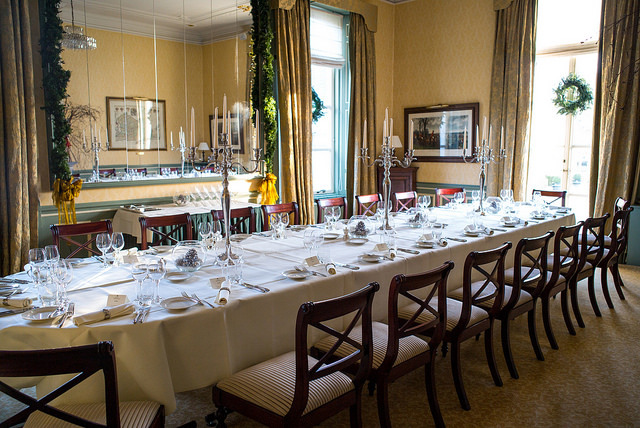
#Summary
in order to reach a truly circular economy organizations need to find new ways to collaborate. This ACTION wants to provide a methodology to get those conversations started. You will invite different people to a CIRCLE Dinner and allow them to build new relationships and possibilities.
Created by: @Alice_audrey and @simonlee, the CRCLR e.V. & Agora Rollberg


#Introduction
Imagine being invited to a dinner, where you would encounter some of the leading spirits in a specific field around the table. Women and men steeped in activism, politics, business, literature, the arts, the sciences, history. People who are invited because they are intriguing and delightful to spend a stimulating evening with.
And an evening like this is also a prime source of education for all the participants. All of whom were engaged citizens, eager to share and debate and move things forward in the direction of sustainability and circular economy based on open source and diversity.
That is an original CIRCLE Dinner. CIRCLE Dinners are opportunities to connect people and foment discussions about many different topics. As a result, vibrant networks and a host of passionate connections are created around important causes.
#You Need For It – Methodology
For a CIRCLE approximately twelve individuals, some of whom may already know one another but others of whom do not, gather in dining room for an evening of food and shared conversation with a purpose.
The dinner is often organized under the auspices of a particular organization, and the attendees may includes one or more individuals who are somehow associated with that organization—as staffers, board members, donors, or partners. However, the dinner is usually hosted by someone not directly affiliated.
There should be no dominant individual who will serve as the focal point or “star” of the evening.
The dinner invitation includes a request for a brief written biography of the attendee. These bios are emailed to the participants a day or two before the dinner, so those who’ve never met before will have a least a general sense of the identities and interests of their dinner companions.
###Methodology
Unlike a fundraising event, there’s no formal presentation about a cause, an organization, or a social problem, nor is there a pitch for contributions or memberships. The purpose of the CIRCLE Dinner is to build a sense of community and partnership around a shared interest or theme.
Most important, the dinner should be held in a setting where everyone in attendance can easily participate in a single conversation. Unlike the typical dinner party, guests are not encouraged to engage in one-on-one dialogues with their partners on either side.
To launch the conversation at a CIRCLE Dinner, a pre-announced question is used to elicit personal feelings, stories, and experiences relevant to the evening’s theme. Crafting the right initial question for a CIRCLE Dinner is important. It must be designed to elicit stories (rather than, for example, canned opinions, theoretical discussions, or examples drawn from the media). Avoid a question that can be answered with a Yes or No, while also choosing a question that can be answered in around two minutes. The goal is to enhance the potential for personal connections among the guests, as well as a personal connection with the evening’s theme.
###Moderation
Moderating a CIRCLE Dinner is an art in itself. The exact nature of the follow-up questions you ask may vary depending on the specific goal of the dinner. One effective approach is for the moderator to gently guide participants along the pathway of the public narrative. That is, after each attendee has had a chance to describe one or more personal experiences related to the theme of the evening (a story of self), the moderator can ask how these experiences are connected with the interests of the entire group (a story of us) and then with the question of the dinner itself.
###Outcome
Finally, as the time for concluding the dinner approaches, everyone in attendance is asked how they plan to follow up on the evening’s discussion. There’s no pressure to respond in a particular way. One participant may offer a response as simple as “I intend to learn and think more about the topics we’ve discussed.” Another may make a specific commitment growing out of the evening’s conversation. And occasionally, the follow-up promises include the birth of a major new commitment. Every response, from the most modest to the most ambitious, is entirely acceptable.
#STEPS
##Step 1: Planning (Beginning Four Weeks in Advance)
Invite between 8 and 15 people who have a common interest. It’s usually best to invite a mix of people, some of whom know one another while others do no.
Avoid inviting a “big kahuna”—a celebrity, powerful business executive, or political leader whose power or charisma are likely to lead others at the dinner to defer to him or her. Everyone at the dinner should feel equally free to contribute.
If the dinner is to be focused on an objective, tailor a topic that will interest the dinner participants.
Select an opening question that is related to the dinner theme and encourages each person at the table to tell a personal story.
Solicit brief written biographies (100-150 words) from each participant in the dinner.
Send out the opening question and biographies ahead of time so people will be ready to carry on the conversation.
Select a dinner moderator—someone with a light style but who can move the conversation around and stimulate discussion.
##Step 2: During the Dinner
####7 p.m.
Cocktails, light conversation before seating.
####7:30 p.m.
Moderator opens by explaining the ground rules.
- Most important rule: No talking to your neighbor; we are having a whole-table conversation.
- Ask each person at the table to respond to the opening question.
- Moderator introduces a follow-up question to link the opening answers to the general theme of the evening.
- Let the discussion begin! Moderator should keep the conversation relevant, prevent side discussions from breaking up the table, and ensure that no one or two people are overly dominant.
####9:15 p.m.
Moderator asks each person at the table to describe any ideas or thoughts they had during the discussion that they would like to follow up on or work with someone on
####9:30 p.m.
End dinner. Informal one-on-one conversations usually continue.
##Step 3: After the Dinner (Within Two Weeks)
- Send out note with the follow-up points listed at the dinner’s end
- Sharing participants contact information
- Set up one-on-one meetings or a sub group meeting with the dinner attendees they thought were interested in following up
##Step 0: Document
If you decide to set up a dinner, let us know about it by posting a comment. Share your question(s) and public narrative. And surprising outcomes or what you have learned. Post it below in the comments or on your own website – but please share a link to this website below.
#Attached Resources
#Credits
Compiled from various resources found on the internet and largely inspired by: http://www.thegenerositynetwork.com/resources/jeffersonian-dinners/